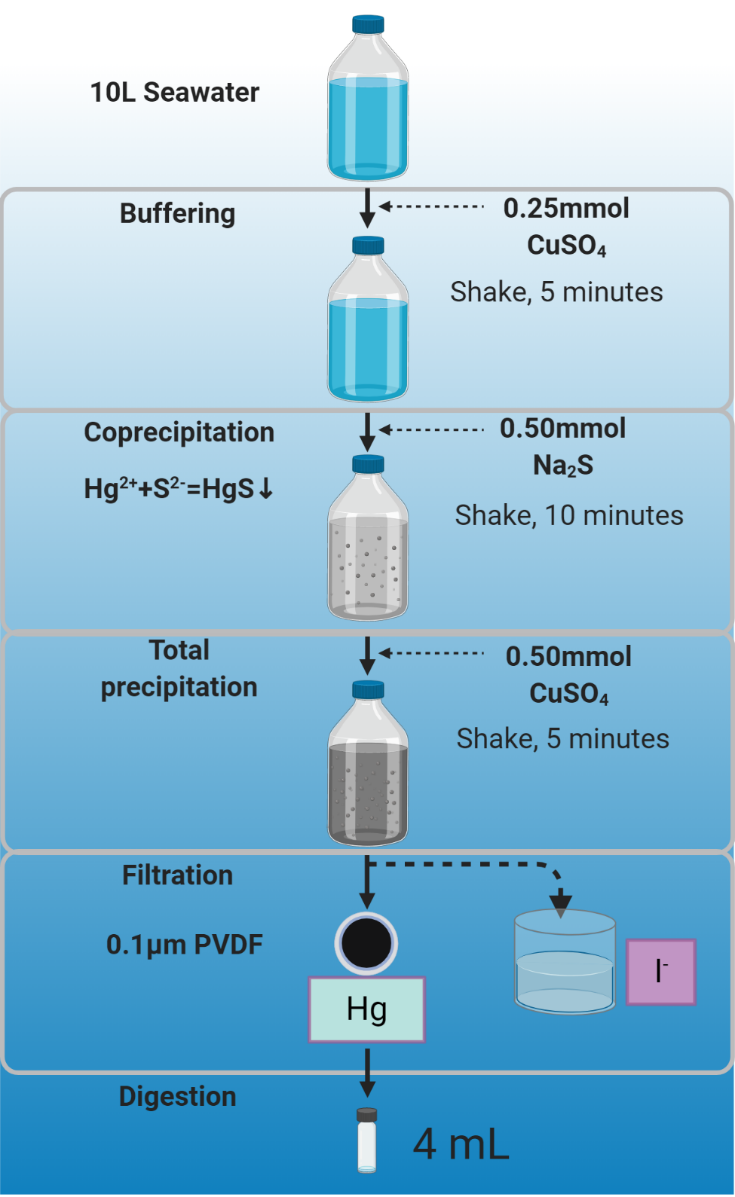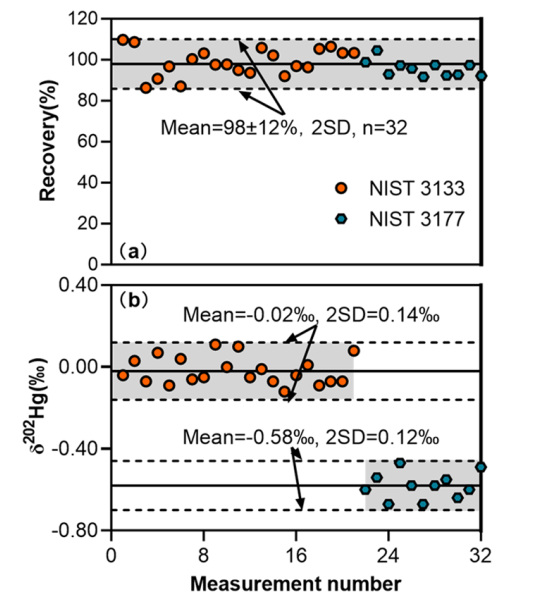近日,我院同位素前沿科学研究中心创建了海水痕量汞浓缩提纯并精确检测其稳定同位素组成的方法,在金属同位素研究方面取得新进展,相关研究结果以“Coprecipitation of mercury from natural iodine-contained seawater for accurate isotope measurement”为题在国际知名期刊Analytical Chemistry上发表。
汞是一种可全球传输的重金属污染物。工业革命后,全球汞排放显著增加,海洋作为汞重要的源和汇,极大的影响着汞的全球循环,亟待深入研究,而海水汞同位素组成可能是研究海洋汞的来源及其生物地球化学循环的有力工具。然而,目前海水汞同位素研究还极为缺乏,主要原因是:海水中汞浓度极低,基质复杂,且汞与碘离子结合能力强,现有的水体汞同位素分析及前处理方法(汞还原法或阴离子树脂交换法)都难以完全分离/提取海水中的汞,这导致海水汞同位素分析成为当前汞同位素地球化学领域的主要难点之一。
因此,我院陈玖斌教授课题组开展了海水痕量汞浓缩提纯方法,选择了与汞结合能力较强的硫离子去分离、富集海水中的汞,成功建立了空白低、回收率高的海水汞共沉淀富集方法,使精确研究海水汞同位素组成提供了可能。该方法的具体步骤为:首先加入0.5 mL 0.5 M CuSO4, 晃匀5分钟之后,再加入1 mL 0.5 M Na2S,随后震荡10分钟,最后加入1mL 0.5 M CuSO4并摇匀(适用于10L海水)。该方法可获得98±12%(2SD)的回收率,同时流程空白较低(~103 pg, n=8)。此方法用NIST 3133和NIST 3177标准模拟样品加入海水中,经浓缩提纯后,NIST 3133与NIST 3177模拟样品的δ202Hg值分别为 -0.02±0.14‰ (n=21, 2 SD)与-0.58±0.12‰ (n=11, 2 SD),与以往报道的标准值类似,证明该海水共沉淀汞富集方法准确度高,重现性较好。
利用该方法,我们分析了采集于黄海的2个海水样品及渤海的4个海水样品。海水样品总汞浓度变化范围为0.34~1.07 ng/L,汞富集回收率为108±15%。样品处理流程空白为148.9 pg (n=3),低于样品所含汞量的5%。同位素结果显示,δ202Hg的范围为-2.65‰至-0.36‰,Δ199Hg的范围为0.13‰至0.56‰。大多数数据点(δ202Hg和Δ199Hg)都在实际大气沉降汞同位素组成范围内,这一结果表明大气沉降可能是沿海海水汞的重要贡献源。与之前报道的全球湿沉降数据(0.38±0.58‰,n=182,2 SD)相比,海水样品显示相对较低的Δ199Hg(Blum et al. 2014; Enrico et al. 2016),表明可能有其他的贡献源(例如,Δ199Hg接近于零的地质或人为输入)。另外,近海样品汞浓度相对于远洋海水高,也支持人为源输入的推论。对近海海洋水体汞同位素组成的初步研究,证明了汞同位素在示踪海洋汞生物地球化学过程及海洋与其他储库交换通量方面的巨大作用。
中科院地球化学研究所博士研究生刘玉龙为论文第一作者,我院陈玖斌教授为通讯作者,郑旺教授参与指导了研究工作,蔡虹明博士、袁玮博士、博士研究生刘剑峰、博士研究生盖鹏雪参与了部分样品采集和数据分析工作。
该研究受到国家重点研发计划(2019YFC1804400)、国家自然科学基金(41625012; 41961144028; U1612442)支持。
论文链接:https://pubs.acs.org/doi/full/10.1021/acs.analchem.1c03060



【论文摘要】Oceans play a key role in the global mercury (Hg) cycle, but studies on Hg isotopes in seawater are rare due to the extremely low Hg concentration and the lack of a good preconcentration method. Here we introduce a new coprecipitation method for separating and preconcentrating Hg from seawater for accurate isotope measurement. The coprecipitation was achieved by sequential addition of 0.5 mL of 0.5 M CuSO4, 1 mL of 0.5 M Na2S and 1mL of 0.5 M CuSO4 reagents, which allowed for quantitatively precipitating Hg from up to 10 L seawater. The protocol was validated by testing synthetic solutions with varying Hg and iodide (I-) concentrations, and by comparing the reaction times of various reagents added. The method resulted in quantitative recovery of 98±12% (n=32, two standard deviations, 2 SD) and relatively low procedure blank (103 pg of Hg, n=8). The precipitates were filtrated and analyzed for Hg isotopes. Repeated measurements of synthetic seawaters spiked with certificated standard materials (NIST 3133 and 3177) using the entire method gave identical Hg isotope ratios with near-quantitative Hg recovery, indicating no isotope fractionation during preconcentration. A total of 6 nearshore seawater samples from the Yellow Sea and Bohai Sea (China) were analyzed using the coprecipitation method. The data showed large fractionation of Hg isotopes, and revealed possible impact of both atmospheric and anthropogenic inputs to coastal seawater Hg budget, implying the potential application of this method in studying marine Hg systematics and global Hg cycling.